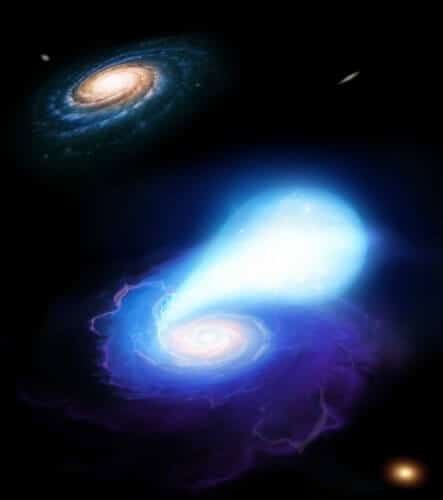A blown-out neutron star and its companion, the white dwarf from their galaxy, collided in the depths of the intergalactic universe

Researchers from the University of Warwick claim to have managed to explain the mystery of the rarest supernovae in the universe. They may be formed as a result of compact double star systems thrown away from their host galaxy, when one of the stars in the pair that became a neutron star undergoes a second trauma when it is attracted to its partner - the white dwarf
It is difficult to understand how in the vast emptiness of space we sometimes detect strange radiation signatures, indicating luminous explosions, although they are neither bright nor prolonged like traditional supernovae, originating in the abyssal void between the galaxies.
A team of astronomers from the University of Warwick in the UK is beginning to understand the nature of these random events often referred to as the loneliest supernovae in the universe. They hypothesize that these events were created by collisions between white dwarfs and neutron stars – both of which were ejected from their own galaxy.
"One of the strangest aspects is that the explosion is observed in unusual places. If you look at a galaxy, you expect all the explosions to occur roughly in line with the plane of the stars." said lead author Joseph Layman of the University of Warwick. "However, a large proportion of them explode at vast distances from their galaxies, in regions where the number of star systems is tiny."
At first, the team speculated that there might be tiny dwarf galaxies hiding below the detection limit, but they found nothing even when they used the best telescopes in the world - the Very Large Telescope in Chile and the Hubble Space Telescope.
"So the question is how did they get there?" Layman mused. About a third of these events occur at least 65 thousand light years from a potential host galaxy.
"We discovered dozens of hypervelocity stars - single stars that escape from their home galaxy, and fly quickly across intergalactic space - and even one runaway globular cluster. Nature has a way of "kicking" systems out of a galaxy, most likely by interacting with the supermassive black hole at the center of each galaxy.
It makes sense that such stars also produce supernovae even after being kicked out of the host galaxy, but this is a rare type of supernova in which huge amounts of calcium are ejected into space. Previous studies show that calcium makes up up to half of the material ejected in these events compared to the very tiny amount of calcium ejected in normal supernovae. It is not yet clear how such a calcium-rich system can be explained.
The members of the research team compared their data to short bursts of gamma rays, which they also saw exploding in distant places from some galaxy. "We think these mysterious bursts occur when two neutron stars collide, or when a neutron star merges with a black hole."
The research team discovered that if a neutron star collided with a white dwarf, the explosion could not only provide enough energy to create the low luminosity of the explosion but could also cause a lot of calcium to be ejected."
"We hypothesize that these are systems that were ejected from their galaxy," Layman said. "A good candidate in this scenario is a white dwarf and a neutron star in a binary system. A neutron star is formed when a massive star ends its life in a supernova event. The mechanism of the supernova explosion causes the neutron star to be kicked to very high speeds (hundreds of kilometers per second). This high speed could cause it to escape from its galaxy, and if a binary star system survives the kick, the white dwarf and neutron star will merge in an explosion.”
Each merger should also produce high-energy gamma-ray bursts, so gamma-ray burst monitoring systems must be calibrated to learn about additional such events.
The article was published on 7/8/14 in the Monthly of the Royal Astronomical Society And it is available online.

4 תגובות
Hello Alon,
Can you provide any evidence for your claims? Can you write a solution of Einstein's equations for a white hole, which is not the opposite side of a charged black hole? Can you reconcile the existence of such a hole with the apparent symmetries of our universe, such as conservation of energy? Do you know that in the big bang there was no emission of matter at all and therefore your repeated use of the term "as in the big bang" is a fundamental error?
Alon Rater
I read the article you refer to.
Your arguments are… not good. You give some examples of concepts that have opposites, and conclude that every concept has an opposite. What is the opposite of a Ford Focus?
The rest of your mumbo-jumbo is irrelevant. Man is another species out of many tens of millions of other species. The uniqueness of man is that he thinks he is unique...
And maybe explosions in remote places are simply white holes?
See:
http://www.hamataraemet.org/category/%d7%9b%d7%95%d7%aa%d7%91%d7%99%d7%9d/%d7%93%d7%a8-%d7%90%d7%9c%d7%95%d7%9f-%d7%a8%d7%98%d7%a8/